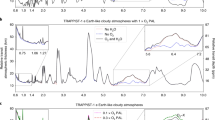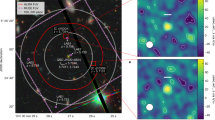Abstract
The absorption line at 26 MHz observed by Konovalenko and Sodin1 towards Cas A was interpreted by Blake et al.2 as the 631α recombination line due to carbon or heavier elements. This was confirmed subsequently by Konovalenko and Sodin3, who detected the 640α line at the same optical depth as the 631α line, within error limits. These lines represent the highest excited states yet detected in interstellar gas and could provide4 a unique diagnostic of conditions in diffuse clouds if observed over a range of frequencies. We now report new observations of these lines carried out near 26, 38, 52 and 68 MHz using the National Radio Astronomy Observatory (NRAO) 91-m telescope at Green Bank. We detected absorption lines at all these frequencies, with a striking fourfold increase in width towards low frequencies due to collisional or radiation broadening. Assuming that these are recombination lines of carbon, the observed radial velocity corresponds well with that of the H I, OH, NH3 and H2CO absorption features that originate in the Perseus arm in the same direction5–8.
This is a preview of subscription content, access via your institution
Access options
Subscribe to this journal
Receive 51 print issues and online access
$199.00 per year
only $3.90 per issue
Buy this article
- Purchase on Springer Link
- Instant access to full article PDF
Prices may be subject to local taxes which are calculated during checkout
Similar content being viewed by others
References
Konovalenko, A. A. & Sodin, L. G. Nature 283, 360–361 (1980).
Blake, D. H., Crutcher, R. M. & Watson, W. D. Nature 287, 707–708 (1980).
Konovalenko, A. A. & Sodin, L. G. Nature 294, 135–136 (1981).
Walmsley, C. M. & Watson, W. D. Astrophys. J. Lett. 255, L123–L127 (1982).
Shuter, W. L. H. & Verschuur, G. L. Mon. Not. R. astr. Soc. 127, 387–404 (1964).
de Jager, G., Graham, D. A., Wielebinski, R., Booth, R. S. & Gruber, G. M. Astr. Astrophys. 64, 17–21 (1978).
Batrla, W., Walmsley, C. M. & Wilson, T. L. Astr. Astrophys. 136, 127–132 (1984).
Batrla, W., Wilson, T. L. & Martin-pintado, J. Astr. Astrphys. 119, 139–144 (1983).
Walmsley, C. M. & Watson, W. D. Astrophys. J. 260, 317–325 (1982).
Shaver, P. A. Astr. Astrophys. 46, 127–130 (1976).
Shaver, P. A. Astr. Astrophys. 47, 49–52 (1976).
Konovalenko, A. A. Soviet Astr. Lett. 10, 846 (1984).
Shaver, P. A. Pramana 5, 1–28 (1975).
Baars, J. W. M., Genzel, R., Pauliny-Toth, I. I. K. & Witzel, A. Astr. Astrophys. 61, 99–106 (1977).
Author information
Authors and Affiliations
Rights and permissions
About this article
Cite this article
Anantharamaiah, K., Erickson, W. & Radhakrishnan, V. Observation of highly excited radio recombination lines towards Cassiopeia A. Nature 315, 647–649 (1985). https://doi.org/10.1038/315647a0
Received:
Accepted:
Issue Date:
DOI: https://doi.org/10.1038/315647a0
This article is cited by
-
A digital correlation receiver for the GEETEE radio telescope
Journal of Astrophysics and Astronomy (1990)
-
Astronomical spectroscopy: Interstellar space contains the largest encountered atoms
Nature (1985)
-
A survey of recombination line emission from the galactic plane at 325 MHz
Journal of Astrophysics and Astronomy (1985)
Comments
By submitting a comment you agree to abide by our Terms and Community Guidelines. If you find something abusive or that does not comply with our terms or guidelines please flag it as inappropriate.



